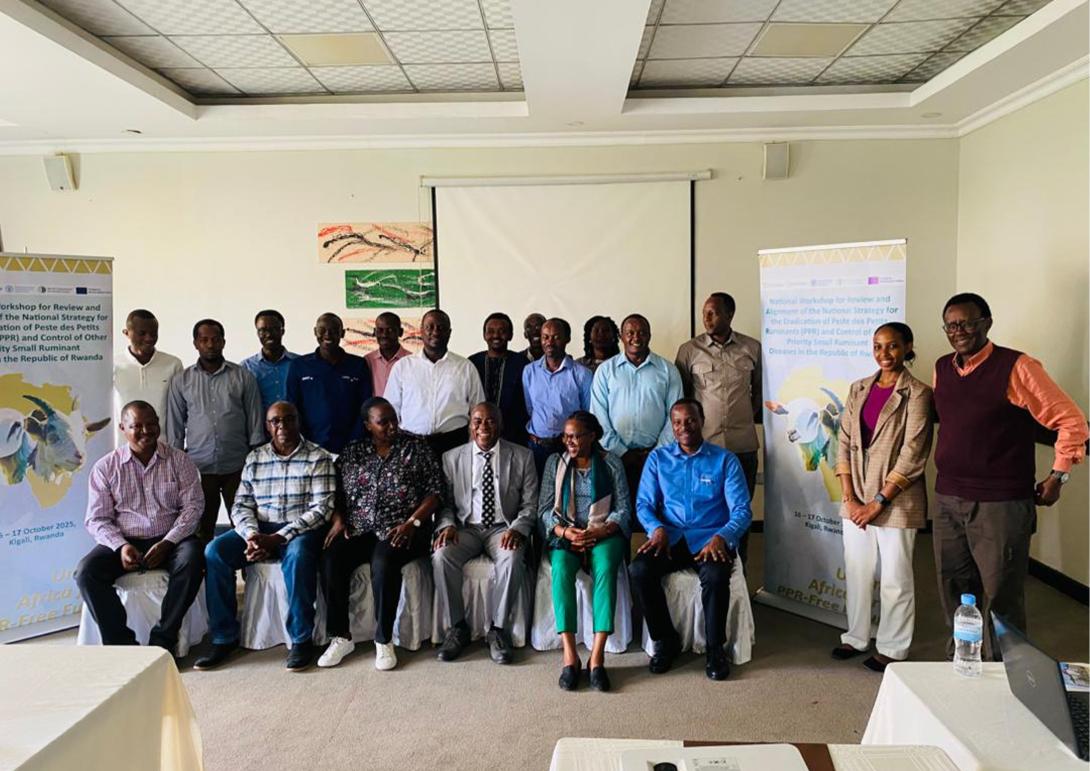
National Workshop to Review and Align the Rwanda National PPR Eradication Strategy 2024-2030 with Global and Continental Frameworks

The 16 - 17th October 2025, La Palisse Nyamata, Bugesera, RWANDA workshop aimed at review the current National Strategic Plan (NSP) for PPR control and eradication, ensure that the NSP aligns with the Global FAO WOAH PPR Strategy and the Pan-African PPR Programme (PAPPR), identify gaps, overlaps, and areas requiring revision or reinforcement, finalize and validation and making ready for endorse the NSP for implementation, and strengthen coordination mechanisms among national, regional, and continental partners.
Peste des Petits Ruminants (PPR), or goat plague, remains a significant threat to small ruminant health and rural livelihoods in almost 70 countries across Africa, the Middle East, and Asia. Associated with high morbidity and mortality, PPR undermines livestock productivity, food security, and the economic stability of small-scale farmers. The FAO and WOAH are spearheading global efforts to eradicate PPR by 2030, under a strategy focused on disease control, strengthening veterinary services, and managing other priority small ruminant diseases.
At the continental level, AU-IBAR leads Africa’s response through updated strategies and programmes, including the Pan-African PPR Eradication Programme (2023–2027). This programme aligns national, regional, and continental interventions, encouraging AU Member States to synchronize efforts using monitoring tools such as the PPR Monitoring and Assessment Tool (PMAT).
Rwanda, with technical and financial support from FAO, WOAH, and AU-IBAR, launched its National PPR Eradication Strategy for 2024–2030 in April 2024. The country is actively tracking progress with PMAT and remains committed to the 2030 international eradication target. This two-day workshop, convened by the Ministry of Agriculture and Animal Resources and supported by AU-IBAR, IGAD\ICPALD, and EAC Secretariat, aimed to ensure national strategy alignment.
- To update stakeholders on PPR’s status and control measures in Rwanda
- To review the national eradication strategy and assess alignment with global and continental frameworks
- To identify gaps and recommend actions for full alignment with international eradication programmes
Key representatives from MINAGRI, RAB, University of Rwanda, Rwanda Development Board, the veterinary sector, goat and sheep breeder associations, private sector, EAC Secretariat, AU-IBAR, NGOs, and district veterinary offices participated, guided by Dr. David Balikowa (EAC Secretariat).
Mr. Jean Claude Ndorimana, Director General of Animal Resources, welcomed participants and emphasized the need for strategy alignment to safeguard livelihoods, boost sector resilience, and fulfill Rwanda’s commitment to PPR eradication by 2030. Regional coordination, harmonized efforts, and efficient resource utilization were highlighted as critical priorities.
Dr. Fabrice Ndayisenda (RAB/WOAH Delegate) presented epidemiological data, risk factors, surveillance gaps, and ongoing interventions. The country faces cross-border disease transmission, limited diagnostic capacity, and prevalence rates ranging from 14.8% (2021) to 71.4% (Bugesera, 2025). Key interventions include national strategy rollout, vaccination campaigns, sero-surveillance, and vaccine monitoring.
Participants reviewed Rwanda’s strategy using global and continental matrices and identified minimal gaps. Recommendations focused on regional cooperation, enhanced surveillance, stakeholder mapping, promoting digital tools, and continuous capacity building for verinarians and paraprofessionals.
- Strengthen cross-border collaborations and harmonize legal frameworks;
- Improve surveillance and diagnostic capacities;
- Foster public-private partnerships and broader stakeholder engagement;
- Allocate sufficient resources and mobilize partner support;
- Leverage digital tools for monitoring and reporting;
- Enhance capacity development throughout the veterinary workforce;
Stakeholders affirmed their commitment to implementation and recommended MINAGRI/RAB incorporate workshop feedback into action plans, expand stakeholder consultations, maintain regular reporting, and formalize Rwanda’s dedication to eradicate PPR by 2030.
